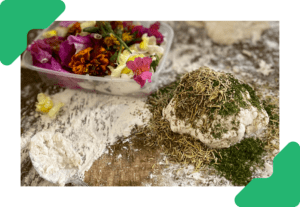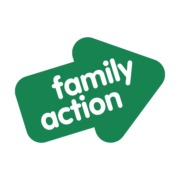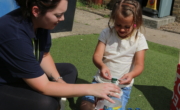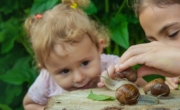This simple guide provides you a bunch of handy tips designed to get you rolling up your sleeves and getting stuck into play with modelling dough.
 What is it?
What is it?
Although available to buy with a variety of brand names, modelling dough is easy to make at home and can be both educational and fun.
This sounds like a lot of hard work… Convince me it’s worth it!
- This activity is as near to free as you can get, so it helps you make the most of your budget
- Play dough is relaxing and fun regardless of your age!
This can be messy, but mess is your friend. Unconvinced? Take a look at our blog dealing with how to take the stress out of mess
Preparation
- To make modelling dough at home simply mix eight tablespoons of plain flour with two tablespoons of table salt in a large bowl
- Then, in a measuring jug add one tablespoon of vegetable oil to 60ml of warm water
- Add the contents of the jug to the bowl
- Lightly dust a surface with a little flour and knead out the dough until it’s smooth
- You’re done!
What are my children secretly learning? (don’t tell them!)
- Modelling dough is great for stimulating the imagination and creativity as it can be moulded into anything
- For younger children playing with the dough can help develop hand-eye coordination and motor skills
- Helping to measure out the ingredients for the dough can develop numeracy skills as well as help with identifying numbers and measures
Top Tips:
Here Pre-School Supervisor Jo Fox from our Birchtree pre-school in Peterborough gives us a few do’s and dough-nt’s regarding how to make the most of a modelling dough session:
- To make coloured dough simply add a few drops of food colouring to the measuring jug before mixing. The more drops the brighter the colour!
- You can also add smells by adding a small amount of scented foodstuffs such as vanilla extract, cocoa powder or cinnamon
- Get your children involved in the process of measuring and preparing the dough – kids especially love preparing the surfaces with flour. Don’t be afraid of the mess… Simply throwing flour up in the air is a valid form of play
- Don’t be tempted to guide their use of the dough too much. Creating a castle, for example, can feel more educational, but by trusting them to play with the dough however they like you’re helping to develop self-reliance and problem solving
- Operating the hot tap under supervision while filling the measuring jug is a great chance to teach children about risk and consequence
- Pasta makes a great accompaniment to dough – try jamming spaghetti into the pasta vertically and threading pasta on to develop hand eye coordination and strengthen muscles
- You can also use the dough to make items such as a “witch’s nose”, which is a great opportunity to explore a little roleplay and develop social skills
- Alternatively you can have a little friendly competition by creating things and then inviting other family members to guess what it is you’ve made.
- You can also use the dough to make “cakes” and “biscuits” and can use extra items such as stones for raisins and “chocolate chips”. This is also a good opportunity to explain that “real” cookies and cakes are also made from dough and explore trying to make these at another time
- Older siblings or other children can write out the recipe and tick it off as they go to develop literacy skills. This also gives you all an excuse to turn off phones and tablets (useful if you don’t want them covered in flour!)

Find out more about Creating Happy Memories through play and the benefits it can bring to your child’s development.










